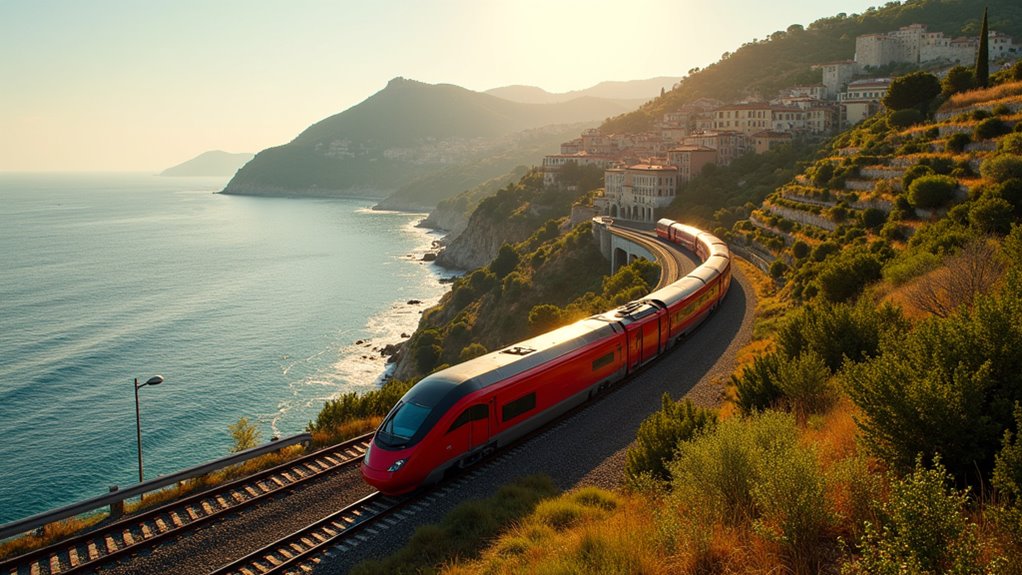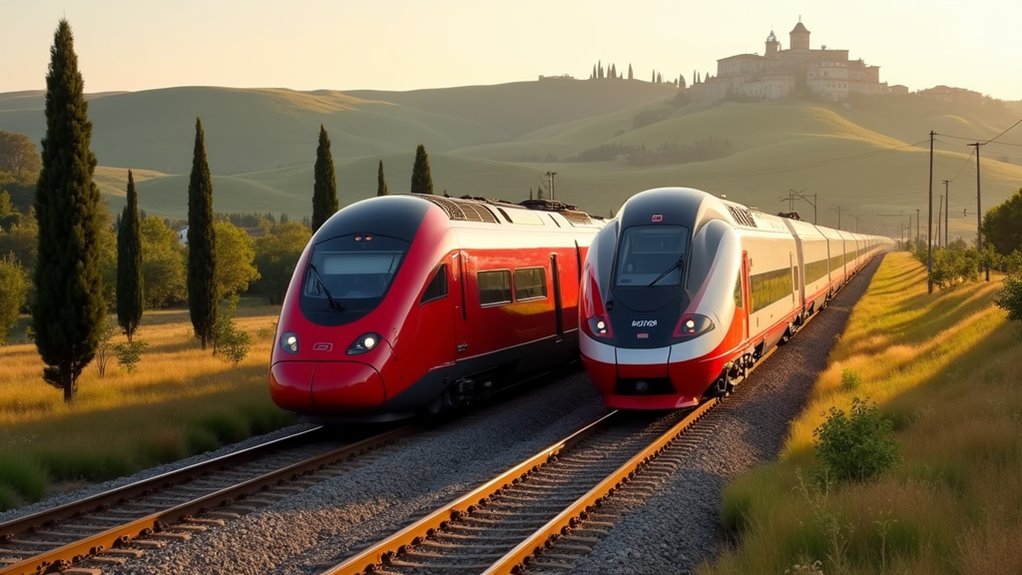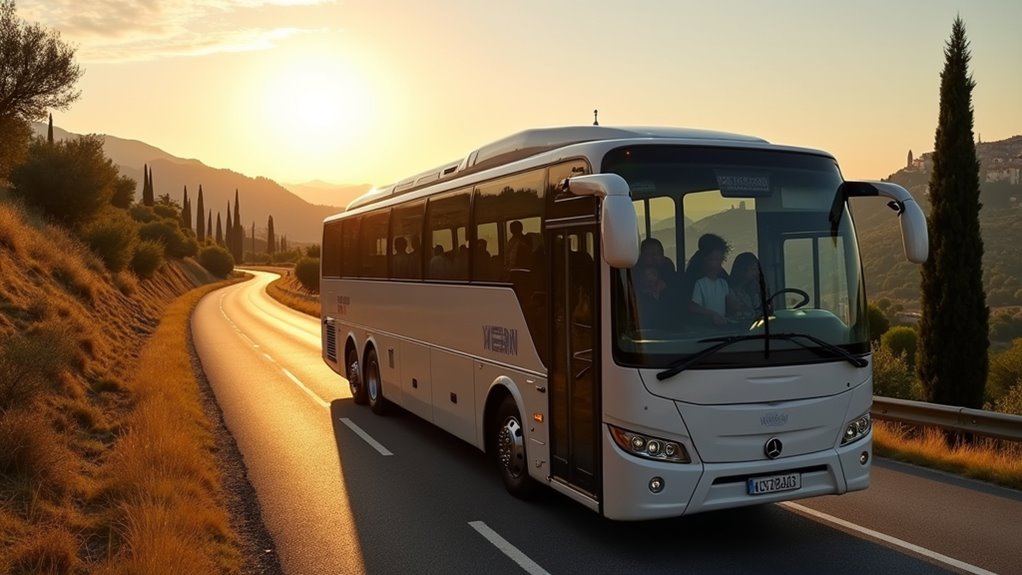Physical Address
304 North Cardinal St.
Dorchester Center, MA 02124
Physical Address
304 North Cardinal St.
Dorchester Center, MA 02124

Keen travelers rejoice: Italy's extensive transport network offers multiple ways to explore its gorgeous cities, but which option suits you best?
Italy offers excellent transport options to suit every budget and schedule. High-speed trains (Frecciarossa and Italo) zoom between major cities at 300 km/h, while regional trains provide affordable access to smaller towns. Intercity buses connect destinations nationwide at lower prices, and ferries link coastal regions and islands. For longer distances, domestic flights save time. Always validate regional train tickets and book in advance for the best deals. The rest of this guide explores each option in depth.

When traveling between major Italian cities, you’ll likely choose between Italy’s two high-speed train services: Frecciarossa and Italo. Both trains reach speeds of 300 km/h and operate on the same tracks between Turin, Milan, Venice, Florence, Rome, and Naples, ensuring similar journey times and reliability.
Italy’s high-speed rail options deliver identical journey times with the same exceptional reliability between major cities.
Frecciarossa (Trenitalia) offers four class options with cloth seats in Standard and leather in higher classes. You’ll find convenient table seating arrangements that maximize scenic views. For refreshments during your journey, Trenitalia provides an onboard bar wagon where you can purchase food and drinks.
Italo (NTV) features leather seats and carpeting throughout all classes, with particularly generous legroom. These trains are perfect for traveling between foodie heavens like Bologna, Florence, and Rome, allowing culinary enthusiasts to sample regional specialties in multiple cities during one trip.
Price-wise, Italo typically runs slightly cheaper than Frecciarossa. However, Trenitalia operates more frequent services, giving you greater scheduling flexibility.
Both offer online booking with promotional fares for advance purchases.
Unlike the sleek high-speed trains connecting major cities, Italy’s extensive regional rail network offers budget travelers an affordable way to explore the country’s smaller towns and countryside. Covering over 16,700 km of track, regional trains prioritize accessibility and coverage over speed. These trains make frequent stops through rural areas and serve as the backbone of local transportation. When traveling with family, regional trains can conveniently connect you to family-friendly hotels in cities like Naples.

While Italy’s trains often steal the spotlight, intercity buses provide a compelling alternative for budget travelers looking to maximize their exploration money. With over 63 companies operating throughout Italy, you’ll find extensive route networks connecting major cities and smaller towns alike.
FlixBus, Baltour, and Marino lead the pack, offering competitive prices, especially when you book in advance. Modern fleets typically include Wi-Fi, air conditioning, power outlets, and comfortable seating—amenities that enhance longer journeys.
You’ll need to purchase tickets before boarding through official outlets, mobile apps, or online platforms. Services run frequently on weekdays with reduced schedules on weekends.
For the best deals and guaranteed seats, book ahead, particularly during peak tourist seasons. Marino Autolinee stands out by connecting more than 140 cities via their intercity routes throughout the country. Many buses even connect to destinations beyond Italy’s borders throughout central Europe.
These intercity buses are especially valuable for reaching charming small towns that might not be serviced by the main rail networks.
As you venture beyond Italy’s mainland, ferries become your essential transportation link to the country’s stunning islands and coastal gems. With over 350 routes available, you’ll find options connecting Sicily, Sardinia, the Aeolian Islands, and even international destinations like Albania.
The beautiful island of Capri Italy deserves special consideration when planning your coastal travels, with its stunning views and exclusive atmosphere.
Ferry schedules for popular routes like Civitavecchia to Sardinian ports are typically released in the autumn, after the peak tourist season has ended.

For travelers covering Italy’s vast distances or reaching its remote corners, domestic flights often prove more practical than trains or buses. You’ll find air travel particularly time-efficient when connecting distant regions like Sicily or Sardinia to the mainland.
Ryanair and ITA Airways dominate the market, offering the widest selection of routes, while budget carriers like easyJet and Volotea provide affordable alternatives. Together, Ryanair and ITA Airways control over 75% of Italy’s domestic seat capacity. Italy’s domestic air travel has rebounded strongly, with seat capacity up 9% compared to pre-pandemic levels.
Consider flying when visiting remote destinations without direct rail connections, or when time efficiency justifies the cost. Major hubs in Rome, Milan, and Venice offer excellent facilities and connections to smaller regional airports. Milan serves as an ideal starting point for a Northern Italy adventure with its excellent airport connectivity to other regions.
Book well in advance to secure competitive fares that may rival train prices.
Whether you’re speeding through Italy on sleek high-speed trains or meandering along coastal routes on budget-friendly buses, your intercity travel choices will shape your experience as much as the destinations themselves. Don’t automatically splurge on premium options when regional trains might connect you to authentic local moments at half the price. Mix your transport methods to balance efficiency with discovery—Italy reveals different faces from rail windows than from ferry decks.